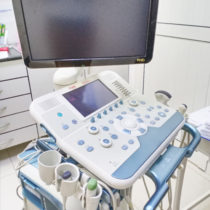A dog/cat ultrasound is the second most common type of diagnostic imaging tool veterinarians use to diagnose a pet’s medical condition. Ultrasounds use soundwaves to examine and photograph internal tissues in real time. An ultrasound allows a veterinarian to see into a dog’s body in real time, allowing for easy viewing of organs from different angles that are not easily achieved through x-rays. The functioning of various organs and blood flow can be observed to determine if they are malfunctioning.

At Blue Oasis Veterinary Clinic, we are committed to the highest standards of excellence in Veterinary medicine. This commitment to excellent care is why we are so trusted by our clients. Surgical protocols at our clinic includes:
The decision to do surgery involves a discussion with the owner about possible complications and all factors to be considered when deciding what is best for your dog.
Factors to think about when considering pet surgery include:
Although the decision to have your pet undergo surgery is ultimately up to you, our veterinary team will present you with all the facts and possible outcomes to help you make an informed, ethical and compassionate decision that is in the best interest of both you and your pet.
Before your pet’s surgery, you will discuss the procedure with your veterinarian and what to do beforehand to properly prepare your pet. In general, it’s a good idea that your pet doesn’t eat anything 12 hours before the surgery takes place. When your pet undergoes anesthesia, it’s best they have an empty stomach or complications may arise. The same holds true for human patients during surgery as well. Your vet will ensure that anesthesia is applied in the safest and most effective manner possible.
For most surgeries, your pet will be put under anesthesia. This helps keep your pet comfortable during the surgery and makes it easier for your surgeon to perform surgery without harming your pet. Before anesthesia is administered, tests will be performed to determine whether your pet’s kidneys and liver can handle the procedure. Afterwards, your pet’s overall health and vitals will be monitored to ensure they are in good condition.
For many veterinary surgeries, your pet will require stitches. Sometimes this involves absorbable stitches which actually dissolve into the skin. However, other stitches, known as skin stitches, require removal about 10 to 14 days after your pet undergoes surgery.
No matter what, it’s important that your pet doesn’t chew or bite on his or her stitches. Sometimes your pet will require a pet cone which will prevent your pet from biting or licking the site of the stitches.
In some cases, your pet can be released following surgery, which allows them to recuperate at home. For other surgeries, your pet should stay in our clinic overnight where our staff can track your pet’s progress and step in if your pet needs any further care.
No matter when you take your pet home, you will likely need to follow some care procedures. Your vet will provide you with detailed instructions about how to take care of your pet. This may include providing your pet with certain medication, keeping certain surgical incision sites clean, or making sure your pet follows a new diet. It all depends on the surgery performed and your pet’s health.
Your pet will also likely be provided with pain medication. Do not provide your own pain medication to your pet, as this may damage their organs and lead to other serious complications.
Street 70, Next to Premier Inn Hotel, Dubai Investments Park,
Green Community – Dubai, UAE
Our Opening Hours:
Monday to Friday : 9:00 am to 9:00 pm
Saturday and Sunday : 10:00 am to 8:00 pm
Damac Hills 2 Community Mall, Dubai, UAE
Our Opening Hours:
Everyday : 9:00 am to 8:00 pm
Blue Oasis Veterinary Clinic
Copyright© 2008 All rights reserved